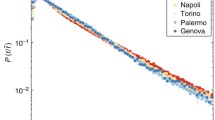Abstract
In this paper we develop models to represent the time until boundary crossing and associated statistics in cellular wireless networks. We propose modeling the terminal movements within a cell by a discrete two-dimensional random walk process. We note that in such an environment mobile units tend to move in roughly a straight line, with occasional backtracking, for a significant period of time before changing direction. We determine the time until crossing an exit point from a circular cell by choosing a random direction from the starting point to an exit point. The user would actually be moving in fluctuating directions until reaching this exit point. Subsequently, we calculate the expected time to reach the exit point as a function of the constant speed of travel and the propensity to change direction en route. The model is rather general and has the potential to be used for highly irregular cell shapes when boundary crossing is not distance-based but determined by propagation attenuation-based criterion.
Similar content being viewed by others
References
Y. Doganata, T. Brown and E. Posner, Call setup strategy tradeoffs for universal digital portable communications, in: ITC Specialist Seminar, Adelaide, Australia (September 1989).
S.A. El-Dolil, W.-C. Wong and R. Steele, Teletraffic performance of highway microcells with overlay macrocell, IEEE Journal on Selected Areas in Communications 7(1) (January 1989).
W. Feller, An Introduction to Probability Theory and its Applications, Vol. 2, 2nd ed. (Wiley, 1971) chapter 12.
R. Guérin, Channel occupancy time distribution in a cellular radio system, IEEE Transactions on Vehicular Technology 36(3) (August 1987) 89-99.
R. Guérin, Queueing and traffic in cellular radio, Ph.D. dissertation, California Institute of Technology, Pasadena, CA (May 1986).
D. Hong and S.S. Rappaport, Traffic model and performance analysis for cellular mobile radio telephone systems with prioritized and nonprioritized hand-off procedures, IEEE Transactions on Vehicular Technology 35(3) (August 1986) 77-92.
B. Jabbari, Y. Zhou and F. Hillier, Random walk modeling of mobility in wireless networks, in: Proc. IEEE VTC '98 (1998) pp. 639-643.
B. Jabbari, Teletraffic aspects of evolving and next generation wireless communication networks, IEEE Personal Communications (December 1996) 4-9.
J.G. Kemeny and J.L. Snell, Finite Markov Chains (Van Nostrand Company, Inc., 1960).
T. Liu, P. Bahl and I. Chlamtac, Mobility modeling, location tracking, and trajectory prediction in wireless ATM networks, IEEE Journal on Selected Areas in Communications 16(6) (1998) 922-936.
S.S. Rappaport, Blocking, hand-off and traffic performance for cellular communications systems with mixed platforms, Proceedings of the IEEE-I 140(5) (October 1993) 389-401.
S. Tekinay, Modeling and analysis of cellular networks with highly mobile heterogeneous traffic sources, Ph.D. dissertation, George Mason University, Fairfax, VA (August 1994).
M.M. Zonoozi and P. Dassanayake, User mobility modeling and characterization of mobility patterns, IEEE Journal on Selected Areas in Communications 15(7) (1997) 1239-1252.
Author information
Authors and Affiliations
Rights and permissions
About this article
Cite this article
Jabbari, B., Zhou, Y. & Hillier, F.S. A Decomposable Random Walk Model for Mobility in Wireless Communications. Telecommunication Systems 16, 523–537 (2001). https://doi.org/10.1023/A:1016639716596
Issue Date:
DOI: https://doi.org/10.1023/A:1016639716596




